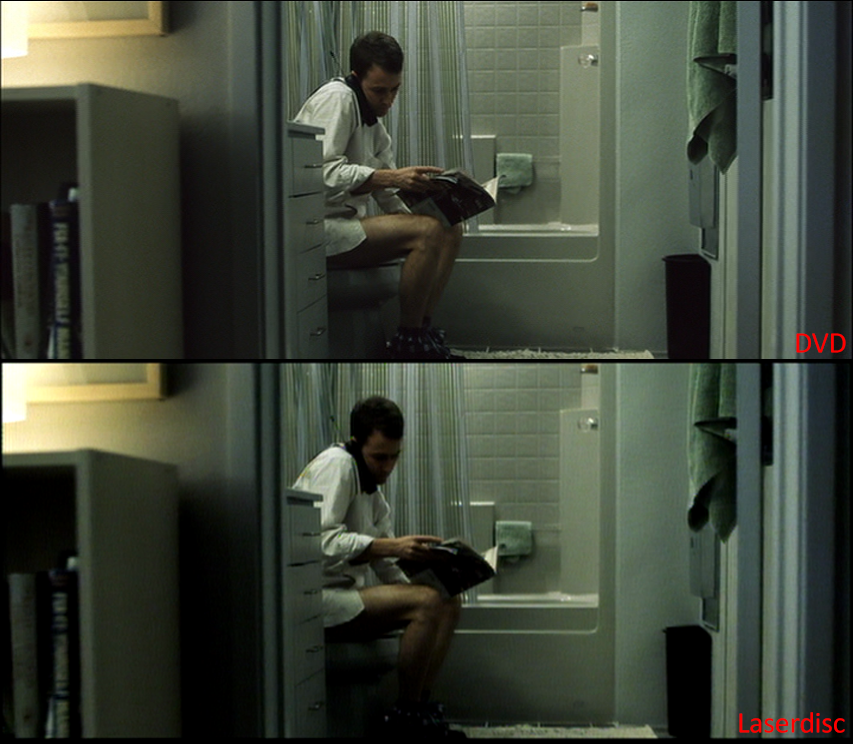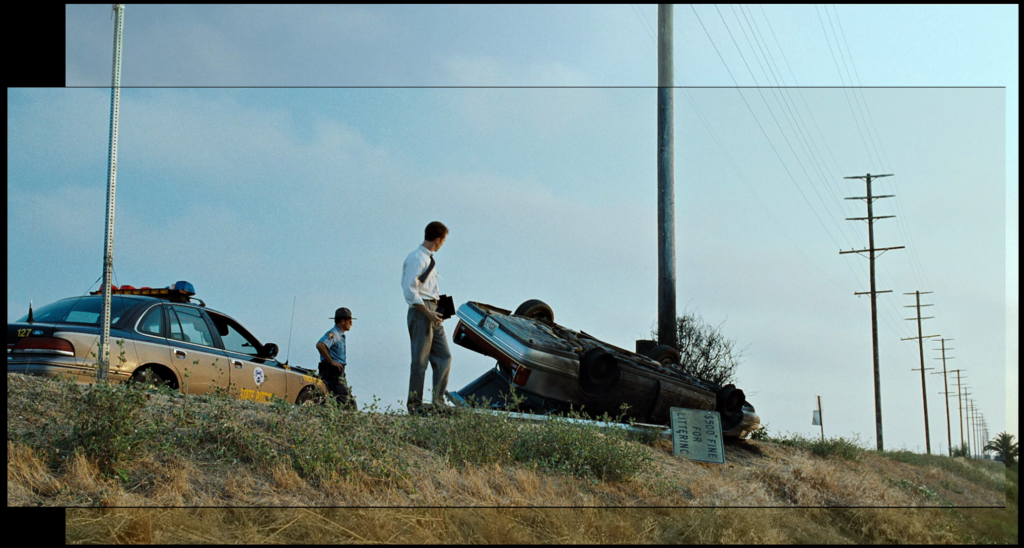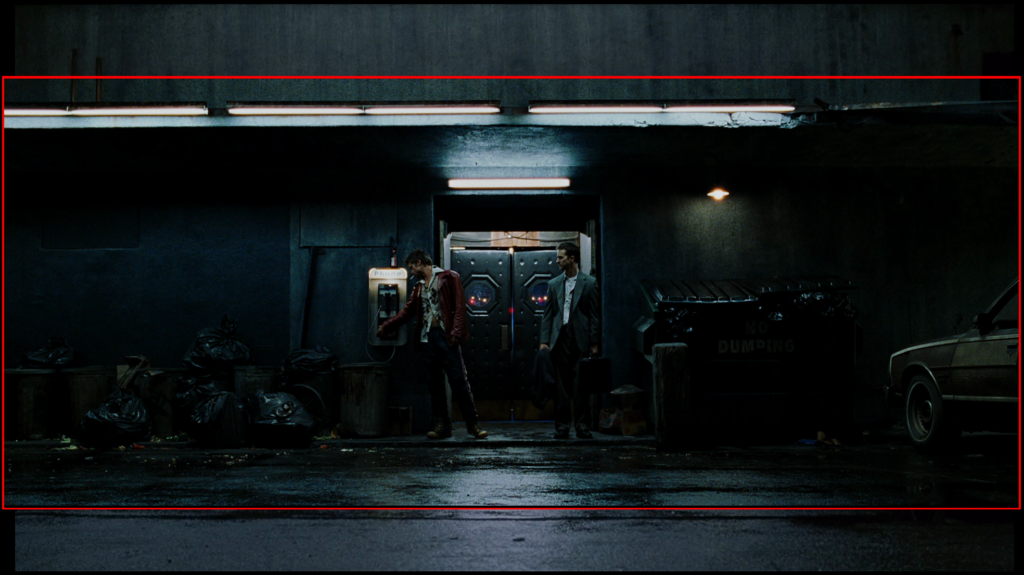Caustic, nihilistic and controversial, Fight Club successfully adapted Chuck Palahniuk’s transgressive fiction novel, it’s a credit to screenwriter Jim Uhl’s excellent adaptation that the voice of the original novel is heard so clearly, and at the same time the film proved to be an enormous success. Though much credit is also due to the excellent sound and editing: so much in this film depends on hitting exactly the right tone.
Based on a reader suggestion, I decided to take a look at the various home video versions of Fight Club that are available.
Filming Fight Club
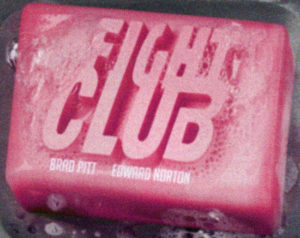
Fight club was photographed by Jeff Cronenweth, a then hot and upcoming Cinematographer who until that point hadn’t shot a major feature, but did have the advantage of being Bladerunner cinematographer Jordan Cronenweth’s son. Fincher has worked with both father and son on a number of projects culminating in ‘Alien 3’. Subsequently Jeff did camera work on a number of Fincher’s other features including ‘Se7en’ and ‘The Game’.
An Interview with Cronenweth in American cinematographer records Fincher’s preference for both natural and pre-existing lighting in locations over elaborate lighting setups. This necessitated the choice of higher speed stocks.
The film was shot using the Super35 format, and framed at 2.35:1. Daylight scenes were shot on Kodak EXR 100T and Vision 250D film, while the majority of night scenes were shot on ‘faster’, grainier Vision 500T.
Selected night scenes from the film were 5% flashed at the laboratory, which boosts contrast and enhances detail in the darker parts of the frame. Additionally a handful of release prints were treated with the Technicolor’s ENR silver retention process (bleach bypass) at the 80 IR level.
Shooting in Super35 at an aspect ratio of 2.35:1 provides considerable latitude for re-framing during the editing process, which David Fincher may have developed a taste for when working on the various home video editions of Se7en.
Home Video Versions
First off – there appear to be just two masters at play:
- The 1999 transfer, used for the Laserdisc, DVD, ‘original’ German Blu-ray, iTunes edition and D-VHS version
- The ~2008 4K transfer, used for all subsequent Blu-ray editions
The 2008 transfer is much sharper than the 1999 transfer and occasionally framed slightly differently, however it is also a little teal-er but not objectionably so. It has been suggested that this transfer has been digitally sharpened/contrast boosted. As you’ll read below, there are certainly a number of shots where I noted evidence of contrast boosting, however I can’t say for sure that it’s been applied the whole feature.
The 1999 transfer is by comparison, softer (even in it’s HD variants) and less contrast-y. According to an interview with Barnes and Noble, David Fincher spent six weeks supervising this transfer, it’s hard to believe that the later editions received the same degree of directorial attention. I suspect that this transfer was done at the same time as the Newline transfer of Se7en, and likely on the same hardware, a Spirit telecine machine to D5 HD video tape.
Fight Club – ‘Brown Paper’ Special Edition DVD
The first Fight Club disc release was the 2000 DVD edition, notable for it’s ‘Brown Paper’ cover. For it’s time it was an awesome DVD, featuring no less than four commentary tracks, a ton of special features, and a 16:9 anamorphically enhanced transfer.
There are reviews elsewhere that enumerate the full list of features and behind the scenes content, I won’t waste your time by repeating them. Suffice to say – it’s an excellent DVD in the context of the time it was released, even today it holds up.
Fight Club – Japanese Laserdisc (PILF-2835)
Split across three CLV sides, the Japanese Laserdisc edition of Fight Club has an almost legendary status. Released in May 2000 in Japan, the month after US Laserdisc production had ground to a halt it’s one of a handful of Laserdiscs that still command more than their retail prices on EBay.
Viewed in isolation the transfer is a pretty decent Laserdisc transfer, however when compared directly to the ‘Brown Paper’ DVD transfer it’s clear why the market for Laserdiscs evaporated in 2000. The Laserdisc transfer is a bit softer, noisier, and has a far lower resolution, as well as being slightly horizontally cropped compared to the DVD. Additionally the Laserdisc has hard Japanese subtitles throughout, though these remain outside the picture area.
Fight Club D-Theater D-VHS Edition
D-VHS was JVC’s last gasp attempt to extend the life of the VHS format in the face of digital obsolescence. With Blu-ray a few years away (but the writing on the wall) D-VHS provided a way to get pre-recorded high definition content into the home. The first D-VHS decks were released before high definition television sets widely available. In fact I ended up using an enormous Sony CRT production monitor (a HDVS system HDM-2830) to view the meager content available.
The D-VHS version of Fight Club comes in a standard D-Theater silver/grey clam shell case. The transfer is encoded as a standard D-theater MPEG-2 video stream with a Dolby Digital 5.1 audio stream at 448kbps and a Stereo track at 192kbps. Overall the stream has a constant bitrate of around 23Mbps.
The transfer generally looks good, much better again than the Brown Paper DVD.
However one question that keeps jumping out at me when I watch this transfer is: “Did I just see some noise reduction artifacts?”. I spent considerable time repeatedly watching sequences, and I’m not sure if it’s MPEG-2 artifacts or 3:2 pulldown artifacts, but very occasionally I see something odd that looks like noise reduction, however when I advance frame-by-frame I don’t see it. I couldn’t come to a definite conclusion on this. So I’m going to leave this as ‘Not Proven‘ for now
2008 ‘original’ German Blu-ray
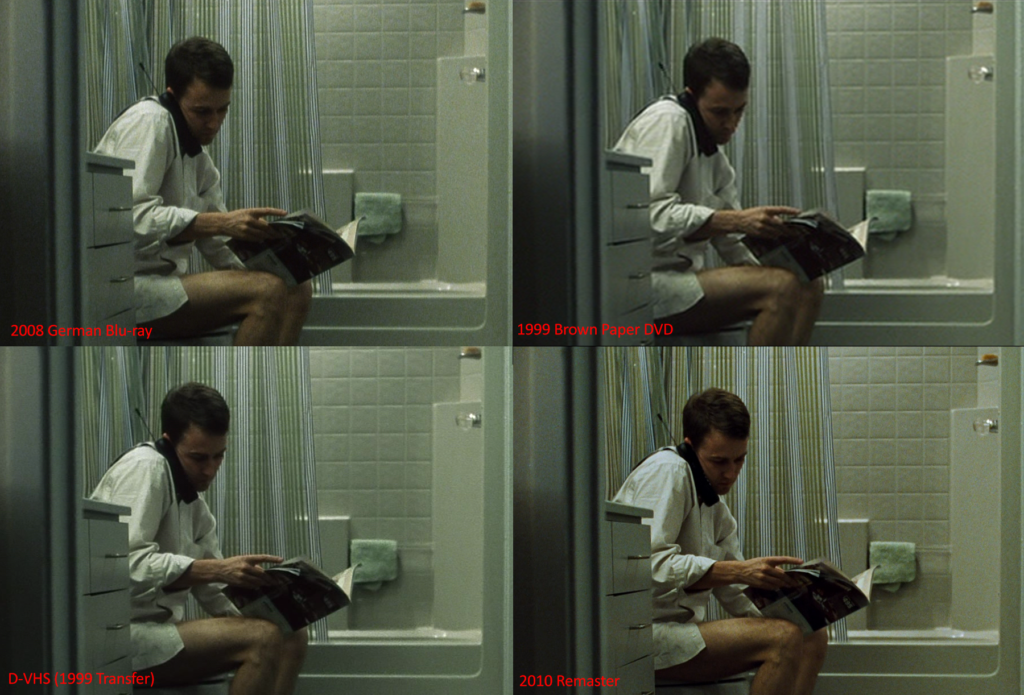
While Edward Norton shops, we compare the ‘original’ 2008 German Blu-ray with the other versions. Screenshot via Blu-ray.com
In 2008, the first Blu-ray edition of Fight Club was release – in Germany to somewhat disappointing reviews. The online commentary available suggests it was the same as the DVD or D-VHS transfer and very disappointing.
Based on images on Blu-ray.com the elusive 2008 disc is almost certainly the 1999 transfer (based on framing), but I haven’t been able to source a copy. Also using the screenshots it’s easy to confirm it’s not an up-scaled version of the DVD. The above screenshot’s shower curtain proves itself useful as a zone-plate.
2008 re-issue and 2010 ’10th Anniversary’ Blu-rays
I’m lumping a large number of discs into one basket here. There are certainly differences between the 2008 German re-issue and the 10th Anniversary re-issue in terms of codecs and soundtrack options.
These all seem to have the 2008 transfer.
Again other sites are better enable to enumerate the differences here.
Fight Club – iTunes HD
Apple have recently changed the availability of 1080p downloads on older version of OSX, which somewhat breaks my review workflow. As a result I’ve been forced to review the 720p version. The 720p iTunes download clocks in at 4.8GB, soundtrack is covered by a 5.1 AC-3 track at 384kbps and Stereo AAC tracks in English, French and Spanish at 160kbps. The file also includes 35 subtitle tracks!
Metadata in the file suggests it was encoded in May of 2017, which is interesting, because it’s the 1999 transfer, and it looks pretty robust. Being only 720p there isn’t a huge amount of resolution.
Fight Club – Matted vs Unmatted
At some point I acquired a 16:9 aspect ratio off-air recording of Fight Club. This is interesting, as we get to see some of the versatility of Super35, in particular the vertical and horizontal latitude for re-framing.
2008 Transfer Anomalies
As mentioned earlier there are a few differences that suggest some digital detail and or contrast enhancement in the 2008 transfer. This particular shot jumps out at me:
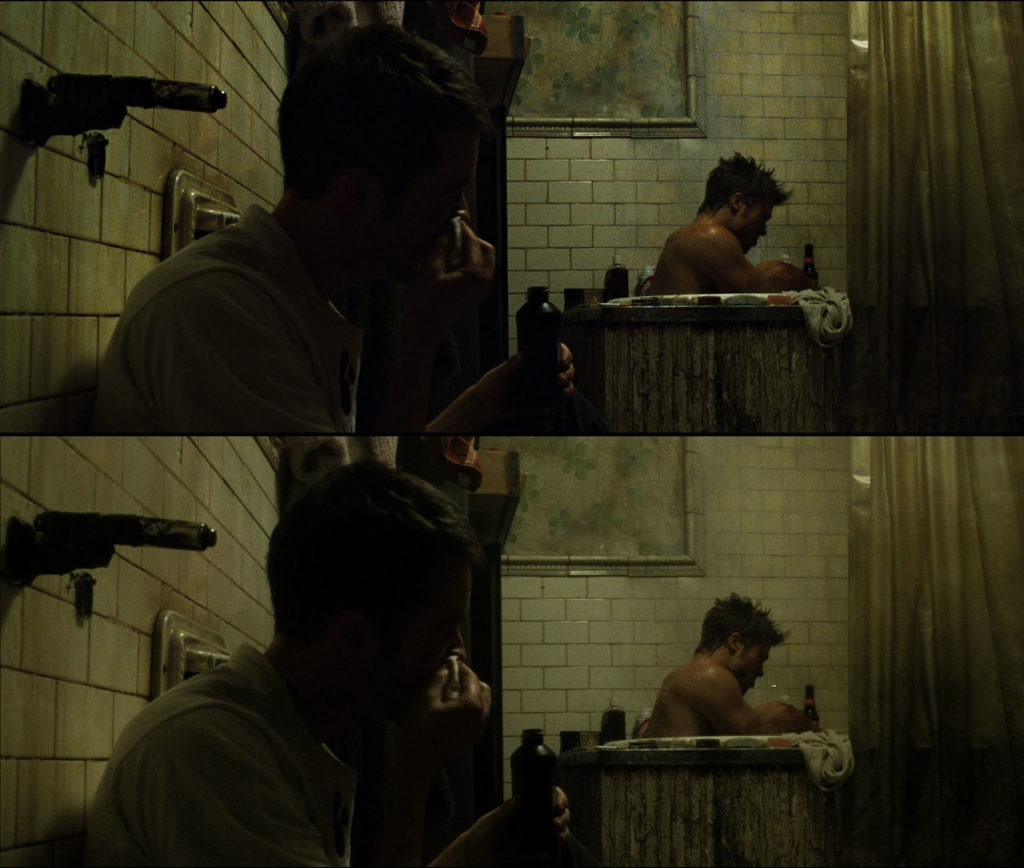
Upper is the 2008 transfer, lower is the 1999 transfer (D-VHS edition). Not exactly the same frame, but look at the flowers …
In particular the green flowers, in the 1999 transfer they are so faint that they almost disappear into the background, but in the 2008 transfer they really jump out along with the brown stain on the image. Also note the specular reflection on the border underneath the tiles and on Tyler’s shoulder both are so well defined you could etch glass with them. Here they are in isolation.
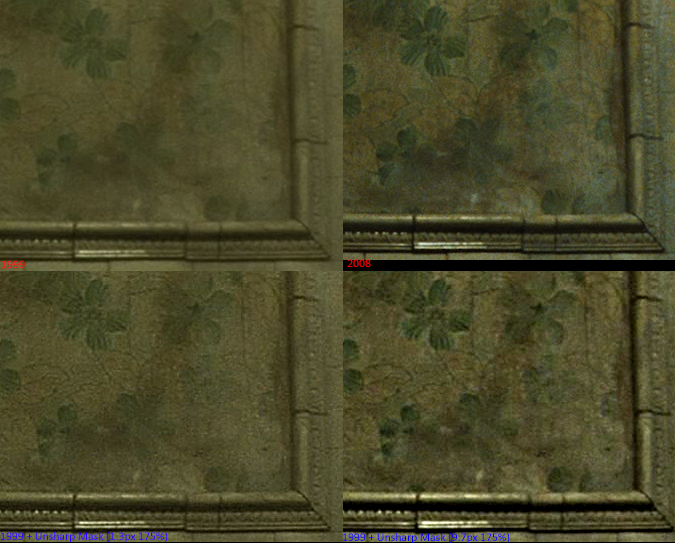
Fight club transfers 1999 vs 2008. Bottom transfers are with varying amounts of unsharp mask applied
The flowers are not tiny details, where the difference in prominence could be explained by insufficient MTF in the original 1999 transfer, likewise the sudden increase in prominence of the stain is very odd. Both these things could be explained by frequency selective contrast boosting which would make both more visible. In the above image I’ve applied varying amount of unsharp mask (bottom row) to the 1999 transfer, and achieved an effect similar to the 2008 transfer, not the increased prominence of the ‘star’ and the stain. Certainly it looks contrast/sharpness boosted to me.
Now this might just be one shot that was a bit soft, and someone decided to dial up the sharpness when coloring the new transfer, or it could be that the entire transfer has been juiced? I simply don’t know.
So the other question would be: Is this just the 1999 transfer sharpened? I think not: Comparing frames by overlaying them throughout the feature I can see subtle geometric differences in the shots that suggest this is a fresh transfer. I certainly can’t see any good reason why anyone would introduce such changes deliberately.
So what is the 2008 transfer? I think this is a fresh transfer from camera negative, it’s got a tiny bit more resolution/MTF than the already pretty good 1999 transfer, possibly it’s a 4K scan. However it’s been sharpened/contrast boosted to make it look consistently more impressive than the 1999 transfer. This was necessary because the useful part of the resolution of 35mm motion picture film (MTF wise) is already captured in the 1999 transfer. Why? There are three ways to fill a 4K frame with sharp pixels from a film source:
- Shoot using a ‘slow’ very high resolution film (Kodak Vision3 50D for example) under studio light conditions
- Use bulky, awkward, larger format cameras (70mm, IMAX) with faster, grainier film (Kodak Vision 3 500T) that will result in smaller, finer grain in the final image
- Apply digital filters to boost the perceived sharpness
A great deal of Fight Club was shot on location with minimal lighting setups on ‘fast’ grainy film. So that leaves a single possibility: digital filtering shenanigans.
It’s also worth mentioning that there are a few framing differences also worth noting: during the final sequence where Tyler/Jack and Marla watch the buildings explode/collapse, the framing on the shot before they hold hands and the shot after they hold hands is different in the 1999 transfer, but identical in the 2008 transfer. So why make the framing different between the two shots in the first place ? Because Helena Bonham-Carter and Edward Norton aren’t the same height (in fact he’s nearly a foot taller), so she has to wear some pretty extreme high-heels to match-up the difference in height to get the desired side-by-side framing.
A long time ago I acquired a terrible quality workprint copy of Fight Club which helps show why the framing is different.

Framing differences in the final sequence. Note the chopped off ankles in the workprint. Frames not identical.
In the workprint the shoes are largely hidden by framing, presumably an explicit choice. However this decision seems to have been revisited by the time of the video transfer and they reframed to show the shoes. Cutting off people at the ankles is generally a composition no-no, and it seems likely they correctly concluded that nobody was going to be paying attention to Marla’s shoes during this scene anyway. However the framing between the two shots (before and after holding hands) is different in the 1999 transfer, likely the ‘ghost’ of the earlier decision. The 2008 transfer, however, makes the framing identical, which make have been Fincher cleaning-up or it may have been someone else making a random decision during telecine.
What was the theatrical framing ? I have no idea. But I suspect that it matched either the workprint framing or the 1999 transfer framing.
Conclusions
Ultimately, there are two home video versions of Fight Club, based on either the 1999 or 2008 transfer.
The 1999 transfer has the advantage of being truer to the original theatrical presentation of Fight Club by not being digitally sharpened and having a few framing differences that are (probably) closer to the theatrical version. Of the versions of the transfer I acquired – I liked the D-VHS version the best despite its occasional possible noise-reduction/artifacts. However the out-of-print ‘elusive’ German Blu-ray is likely the best version of the 1999 transfer.
The 2008 transfer is sharper, but may have been a bit mucked around with digitally, and has a few minor framing differences. Neither of these things are particularly objectionable, and watching it in isolation you’d be hard pressed to call out these differences. However, if you are a purist, you are going to want to watch the 1999 transfer.
One thing is for sure: I like this movie so much I have to fight to stop myself from re-watching multiple times during this review.
An inconclusive review? I am Jack’s complete lack of surprise.
January 2019 Update – Original 2008 German Disc Located
I took a chance on a copy of the German 2008 Blu-ray Steelbook I saw on eBay being the original transfer – and I got lucky! Just as I suspected – it is the 1999 transfer, and it does look a bit better than the D-VHS.
If you can play the disc – the most obvious difference is at 19:21 (the shot of Edward Norton looking at the crashed car with the voiceover saying “…You wake up at O’Hare, Dallas Fort Worth…” ):
- The 1999 transfer is framed so that on the rear of the Ford police car on the left of the frame you see only about two thirds of the Ford logo above the tail-light and nothing to the left of it.
- The 2008 transfer shows both the whole Ford logo and the yellow number 127 to the left of it.
Good luck!

